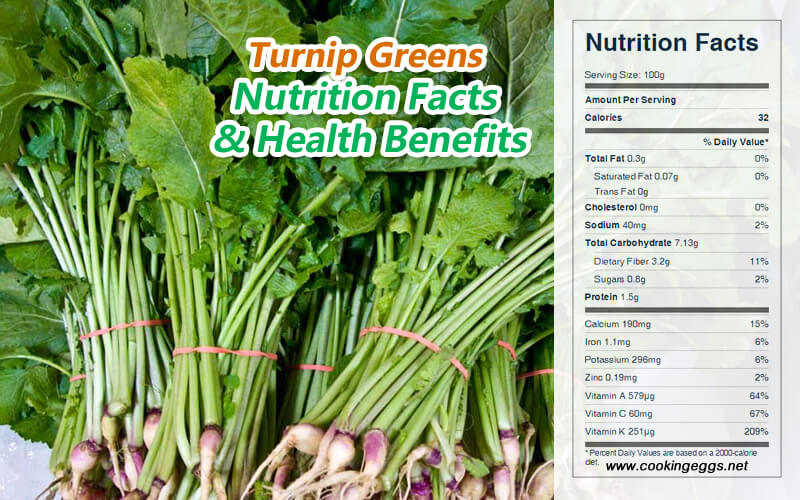Turnip Greens Nutrition Facts & Health Benefits
Turnip greens are turnip leaves, both roots and greens that are edible. Turnip greens resemble mustard greens in flavor. Turnip leaves have a pungent flavor that becomes milder after cooking.
Turnip greens are a cruciferous vegetable. Although the root has a long history as a staple food, the tops are much richer in vitamins, minerals, and fiber. The green leaves are a good source of vitamins A, C, and K, as well as folate, copper, and calcium. They are high in lutein and beta-carotene, which help protect eyesight and preserve the linings of blood vessels.
Nutritional Value of Turnip greens
Raw turnip greens are 89% water, 7% carbohydrates, 1.5% protein, and contain negligible fat. They are a good source of vitamin K and vitamin A, and they are also a source of folate, calcium, and iron. Turnip greens also contain substantial lutein.
One-half cup of boiled, chopped turnip greens provides 14 calories, 3.1 g carbohydrate, 0.8 g protein, 0.2 g fat, 2.5 g dietary fiber, 3959 IU vitamin A, 20 mg vitamin C, 85 mcg folic acid, 146 mg potassium, 21 mg sodium, 21 mg phosphorus, 99 mg calcium, and 16 mg magnesium.

Raw Turnip greens Nutrition Facts Label
Health Benefits of Turnip greens
Turnip greens are a common side dish in southeastern American cooking, primarily during late fall and winter. Smaller leaves are preferred, but the bitter taste of larger leaves can be reduced by pouring off the water from the initial boiling and replacing it with fresh water. Varieties of turnip grown specifically for their leaves resemble mustard greens and have small or no storage roots. These include broccoli rabe, bok choy, and Chinese cabbage. Similar to raw cabbage or radish, turnip leaves and roots have a pungent flavor that becomes milder after cooking.
Turnip greens are considered valuable in the diet primarily because of their vitamin A and C content and the minerals calcium and iron. Leafy green and yellow salad vegetables are important sources of vitamin A and vitamin C and contain appreciable quantities of thiamin, niacin, and folic acid.
Turnip greens are rich in vitamin B2 , vitamin B6, and folic acid. Vitamin B6 and folate help reduce levels of homocysteine in the blood, protecting the walls of blood vessels and helping prevent atherosclerosis. They serve as co-factors in cellular reactions, mostly related to amino acid biosynthesis and catabolism, but are also involved in fatty acid biosynthesis and other physiological functions.
Turnip greens are rich in Vitamin A(64% of the Daily Value) and β-Carotene. Vitamin A is essential for embryo development and growth, for the maintenance of the immune system, and for vision. These compounds possess antioxidant properties, and together with vitamin-A, they help protect the retina. It is also an essential vitamin for vision and eye health.
Turnip greens are high in vitamin C, providing about 60 mg per 100 g. Vitamin C is a water-soluble antioxidant that helps scavenge harmful, pro-inflammatory free radicals by virtue of its antioxidant properties. Vitamin C also boosts immunity to fight against flu infections.
Turnip greens contain a similar level of calcium to that found in spinach but without the oxalate, so that about 2 servings of turnip greens provide a similar level of absorbable calcium to one glass of milk.
Turnip greens are loaded with vitamin K. Research suggests that foods rich in vitamin K can help to support cardiovascular health and reduce the risk of osteoporosis. Low levels of vitamin K have been linked with lower bone density and an increased risk of hip fracture in women, and eating turnip greens often significantly reduces this risk.